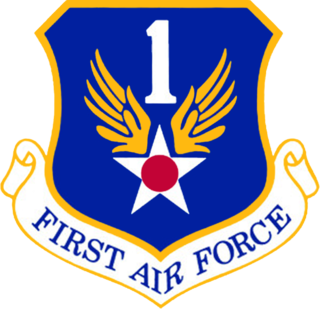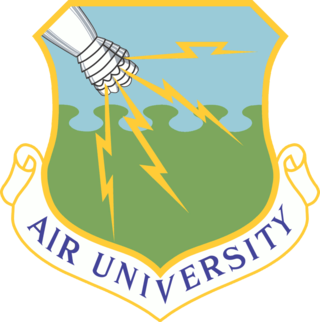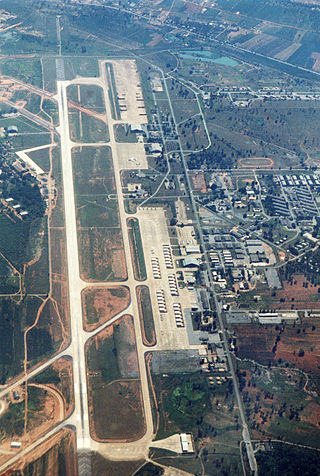
The First Air Force is a numbered air force of the United States Air Force Air Combat Command (ACC). It is headquartered at Tyndall Air Force Base, Florida. Its primary mission is the air defense of the Contiguous United States (CONUS), United States Virgin Islands and Puerto Rico. Since May 2022, it also provides the Air Force contribution to United States Space Command, as Air Forces Space (AFSPACE), including support functions for NASA human space flight.

The Fourteenth Air Force was a numbered air force of the United States Air Force Space Command (AFSPC). It was headquartered at Vandenberg Air Force Base, California.

The Nineteenth Air Force is an active Numbered Air Force of the United States Air Force. During the Cold War it was a component of Tactical Air Command, with a mission of command and control over deployed USAF forces in support of United States foreign policy initiatives. The command was reactivated in 1993 under Air Education and Training Command with a mission of conducting AETC's flying training.

The Pacific Air Forces (PACAF) is a Major Command (MAJCOM) of the United States Air Force and is also the air component command of the United States Indo-Pacific Command (USINDOPACOM). PACAF is headquartered at the Hickam AFB portion of Joint Base Pearl Harbor–Hickam, Hawaii, and is one of two USAF MAJCOMs assigned outside the Continental United States, the other being the United States Air Forces in Europe – Air Forces Africa. Over the past sixty-five plus years, PACAF has been engaged in combat during the Korean and Vietnam Wars and Operations Desert Storm, Southern Watch, Northern Watch, Enduring Freedom and Iraqi Freedom.

Tactical Air Command (TAC) is an inactive United States Air Force organization. It was a Major Command of the United States Air Force, established on 21 March 1946 and headquartered at Langley Air Force Base, Virginia. It was inactivated on 1 June 1992 and its personnel and equipment absorbed by Air Combat Command (ACC).

Osan Air Base is a United States Air Force (USAF) and Republic of Korea Air Force (ROKAF) base located near Songtan Station in the city of Pyeongtaek, South Korea, 64 km (40 mi) south of Seoul. Despite its name, Osan AB is not within Osan City, which is 7.5 km (4.7 mi) to the north. The base is the home of the headquarters for Seventh Air Force, Pacific Air Forces' 51st Fighter Wing, and a number of tenant units. The base is also the headquarters of the Republic of Korea Air Force (ROKAF) Operations Command. Osan Air Base is also the departure and arrival point for U.S. government-contracted "Patriot Express" flights bringing service members and their family members to South Korea from Seattle-Tacoma International Airport in the U.S. state of Washington, Misawa Air Base and Yokota Air Base in Japan.

The Military Airlift Command (MAC) is an inactive United States Air Force major command (MAJCOM) that was headquartered at Scott Air Force Base, Illinois. Established on 1 January 1966, MAC was the primary strategic airlift organization of the Air Force until 1974, when Air Force tactical airlift units in the Tactical Air Command (TAC) were merged into MAC to create a unified airlift organization.

Air University is a professional military education university system of the United States Air Force. It is accredited by the Commission on Colleges of the Southern Association of Colleges and Schools to award master's degrees.

Korat Royal Thai Air Force Base is a base of the Royal Thai Air Force (RTAF) in northeast Thailand, approximately 200 km (125 mi) northeast of Bangkok and about 4 km (2.5 mi) south of the centre of the city of Nakhon Ratchasima in the Nakhon Ratchasima Province, the largest province in Thailand.

The 354th Fighter Wing is a United States Air Force wing that is part of Pacific Air Forces (PACAF). It is the host wing at Eielson Air Force Base, Alaska, and is assigned to the Eleventh Air Force.

The 1st Special Operations Wing at Hurlburt Field, Florida is one of three United States Air Force active duty Special Operations wings and falls under the Air Force Special Operations Command (AFSOC).

The 405th Air Expeditionary Wing is a provisional United States Air Force unit assigned to Air Combat Command. It may be activated or inactivated at any time.
The structure of the United States Air Force refers to the unit designators and organizational hierarchy of the United States Air Force, which starts at the most senior commands.

The 57th Wing is an operational unit of the United States Air Force (USAF) Warfare Center, stationed at Nellis Air Force Base, Nevada.

The 125th Fighter Squadron is a unit of the Oklahoma Air National Guard 138th Fighter Wing located at Tulsa Air National Guard Base, Oklahoma. The 125th is equipped with the Block 42 F-16C Fighting Falcon.

The 433rd Weapons Squadron is a United States Air Force unit, assigned to the USAF Weapons School at Nellis AFB, Nevada.

The 53rd Test and Evaluation Group is a group of the United States Air Force. It is a part of the 53rd Wing, and is headquartered at Nellis AFB, Nevada.

The 307th Bomb Wing is an Air Reserve Component (ARC) of the United States Air Force. It is assigned to the Tenth Air Force of Air Force Reserve Command, stationed at Barksdale Air Force Base, Louisiana. If mobilized, the wing is gained by Air Force Global Strike Command (AFGSC).

Elmendorf Air Force Base is a United States Air Force (USAF) facility in Anchorage, Alaska. Originally known as Elmendorf Field, it became Elmendorf Air Force Base after World War II.

















